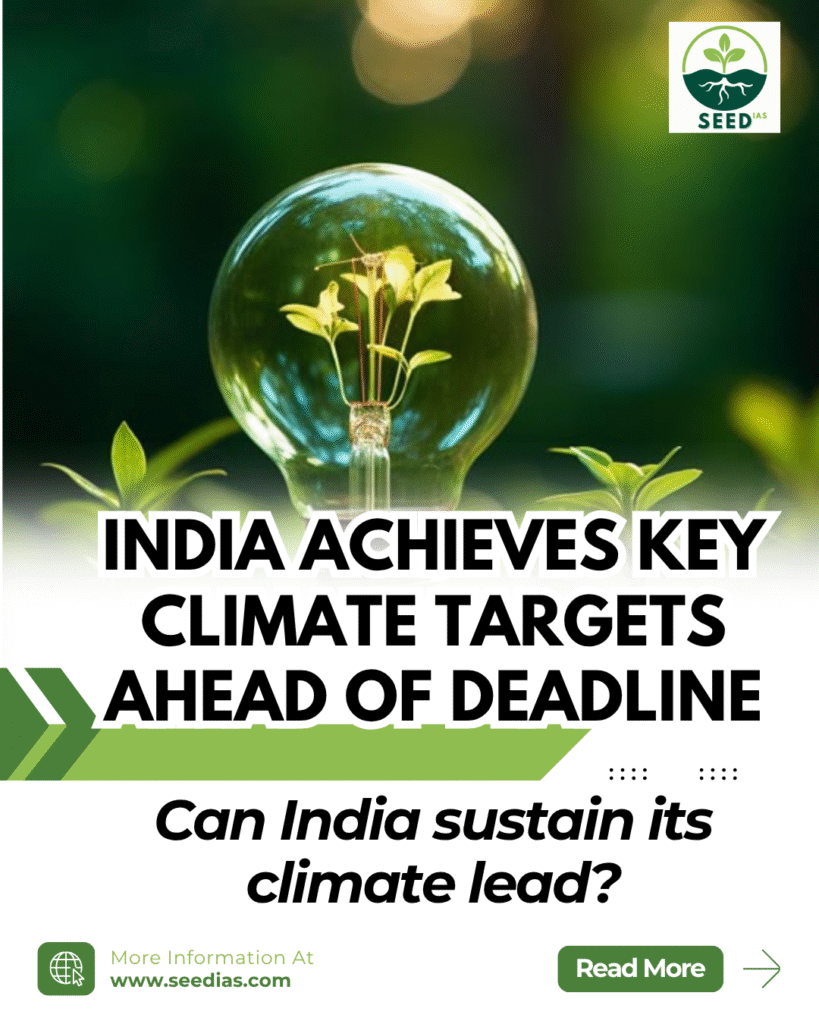Why in NEWS
India has achieved one of its three major Paris Agreement climate targets five years ahead of schedule and is nearing completion of the remaining two.
Key Terms / Concepts
| Term | Explanation |
|---|---|
| Paris Agreement (2015) | A legally binding international treaty on climate change adopted at COP21 to limit global warming to well below 2°C, preferably 1.5°C. |
| Nationally Determined Contributions (NDCs) | Climate action targets set by individual countries under the Paris Agreement. |
| Carbon Sink | Natural or artificial systems that absorb more carbon than they emit, like forests. |
| Emissions Intensity | The amount of greenhouse gas emissions produced per unit of GDP. |
| Non-Fossil Fuel Capacity | Installed capacity from sources like solar, wind, hydro, and nuclear energy. |
India’s Progress on Climate Commitments
| Target | Progress |
|---|---|
| Non-Fossil Fuel Capacity | Achieved in 2024: 242.78 GW out of 484.82 GW (≈50%) from non-fossil sources. |
| Carbon Sink Creation | 2.29 billion tonnes by 2021; likely exceeded 2.5 billion tonnes by 2023. |
| Emissions Intensity Reduction | 36% reduction by 2020 from 2005 levels; target is 45% by 2030. On track. |
Key Government Initiatives Supporting Climate Goals
| Initiative | Purpose |
|---|---|
| NAP | State-wise strategies to combat climate risks. |
| NAPCC | Eight national missions on clean energy, water, agriculture, etc. |
| Sovereign Green Bonds | Raise funds for green projects. |
| MISHTI | Promote mangrove plantations for shoreline protection. |
| Mission LiFE | Encourage sustainable lifestyle practices. |
Concerns in India’s Climate Strategy
| Issue | Details |
|---|---|
| Capacity vs Generation Gap | Only 28% of power generated is from non-fossil sources despite 50% installed capacity. |
| Limited Clean Energy Penetration | Only 6% of total energy consumption is clean; fossil fuels dominate key sectors. |
| Heavy Solar Dependence | 24 GW out of 30 GW renewable additions in 2024 came from solar; other sources lag. |
| Slow Nuclear Growth | Projected to reach only 17 GW by 2030 against 100 GW target by 2047. |
| Carbon Sink Sustainability | Concerns over monoculture plantations, urbanization, and forest encroachments. |
| Data Gaps on Emissions | No verified emissions data post-2020 hampers monitoring. |
| Lack of Climate Finance | Developed nations have failed to meet $100 billion/year commitment. |
Steps to Strengthen India’s Climate Response
| Area | Actions Required |
|---|---|
| Bridging Capacity–Generation Gap | Scale up energy storage (lithium/sodium-ion), smart grids, and transmission upgrades. |
| Diversifying Renewables | Boost wind, hydro, and nuclear via fast-tracked clearances, finance, and subsidies. |
| Sustainable Forestry | Use GIS/remote sensing; promote native species; expand agroforestry and urban greening. |
| Securing Climate Finance | Push developed countries for grant-based finance; attract private/foreign investment and enhance domestic R&D. |
In a nutshell
Mnemonic: SECURE FUTURE
Solar-led expansion
Emissions intensity falling
Carbon sink nearing target
Urbanisation threat to forests
Reliance still high on fossil fuels
Energy storage and finance need push
Prelims Questions
- Which of the following best explains the term Carbon Sink?
a) Area with high solar energy potential
b) Area that absorbs more carbon dioxide than it emits
c) Technology for carbon capture
d) Reservoir for fossil fuel storage - India recently achieved which of its Paris Agreement targets five years ahead of schedule?
a) Reduction of absolute emissions
b) Carbon neutrality
c) 50% electricity generation from non-fossil sources
d) 50% installed capacity from non-fossil sources - What is the main concern associated with India’s carbon sink progress?
a) Deforestation in urban areas
b) Lack of mangrove development
c) Overdependence on bamboo forests
d) Excessive reliance on monoculture plantations
Mains Questions
- India’s early achievement of its non-fossil fuel capacity target is commendable, yet several structural challenges remain. Discuss. (15 Marks)
- What role can climate finance and technological innovation play in helping India meet its Paris Agreement commitments? (15 Marks)
Answers – Prelims
| Qn | Answer | Explanation |
|---|---|---|
| 1 | b | A carbon sink absorbs more CO₂ than it emits, typically through forests or oceans. |
| 2 | d | India met its 50% installed capacity from non-fossil sources ahead of 2030. |
| 3 | d | Monoculture plantations, though fast-growing, reduce biodiversity and carbon resilience. |
















